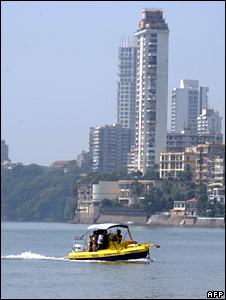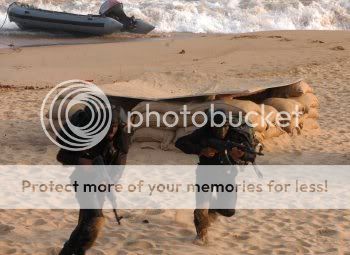Marcos
MARCOS
MARCOS (previously named as Marine Commando Force (MCF)) is an elite special operations unit of the Indian Navy. "MARCOS" is short for "Marine Commandos", and MCF is an acronym for "Marine Commando Force".
The force started off as the Indian Marine Special Force, the first batch qualifying in February 1987. It was later renamed as the Marine Commando Force (MCF) in 1991. The force has gradually acquired experience and a reputation for professionalism over the two decades it has been in existence. It is one of India's highest trained and best equipped forces.
The force was initially trained by the other special forces of the country, including those under the Home Ministry, the Army, Air Force, Police and paramilitary units. This was later supplemented by foreign training facilities, notably the SEALS of the US Navy. Over the years, the force set up its own training facility, first as an adjunct of the operational company at Mumbai, later as the Naval Special Warfare Tactical Training Centre. Wide exposure to different forms of warfare have been obtained through field operations in counter insurgency and anti terrorist operations within the country, and joint exercises with more than a dozen countries across the world.
STRENGTH AND ACTIVITIES
The MCF presently has approximately 600 personnel,though actual strength remains classified.
Operations undertaken:
Operation Pawan (Hindi for Wind): Part of the Indian Peace Keeping Force (IPKF) in Sri Lanka in 1988.
Operation Cactus: Part of the Indian Navy contingent defending the democratic government of President Maumoon Abdul Gayoom of the Maldives from a coup. The force played a supporting role in India's successful military aid in helping foil the attempted coup by Sri Lankan militants from the PLOTE and ENDLF. A group of 47 mercenaries attempted to escape by sea with 23 hostages, on a hijacked vessel, MV Progress Light. The MCF was pressed into service along with INS Godavari, a multi role frigate carrying Seaking helicopters, Alize aircraft operating from the Navy's base at Kochi. INS Godavari trailed the hijacked vessel for a couple of days, firing intermittently with her guns on the vessel's superstructure. An Alize anti-submarine aircraft dropped two depth charges near the vessel, causing the motley collection of militants to come up on the upper decks and surrender. A contingent of the Marcos operating from Ratmalana Airfield on the outskirts of Colombo, with some help from the Sri Lankan Army in terms of specialised equipment, thereafter boarded the ship and accepted the surrender of the militants and took them into custody.
Operation Leech, which resulting in the slaying of a number of Burmese rebels at Narcondum Island in the North Andaman group of Islands. A small contingent of marcos was reputed to have been involved in the murky operation, which has found intermittent mention in various media.
Operation Tasha, which was instituted after Operation Pawan wound up, and was more a coastal security operation on the Tamil Nadu coast to thwart operations of the LTTE there, than something belonging to the realm of special operations.
Operation Swan, which was a similar exercise on the Gujarat and Maharashtra coasts, after the December 92 blasts in Mumbai, wherein the MARCOS were used for patrolling.
The MARCOS are presently deployed at the Wular Lake in Kashmir, one of Asia's largest fresh-water lakes, where they have achieved significant success in counter insurgency operations against Kashmiri separatists and foreign militants.
Protecting offshore oil rigs and platforms. The MARCOS maintain a quick reaction team at Mumbai, to deal with threats to the offshore oil assets at Bombay High.
In its first ever action in the Gulf of Aden, MARCOS thwarted an attempt by pirates to capture the Indian merchant vessel MV Jag Arnav on November 11, 2008.[1]
Operation Black Tornado: MARCOS stormed the Trident and Taj Hotels at Mumbai during the recent terrorist attacks on 27 November, 2008 during the November 2008 Mumbai attacks [2], wounding one terrorist at the Taj, and sustaining two injuries. The second team deployed at the Trident Hotel at Nariman Point (the erstwhile Oberoi Towers) curiously failed to make contact with the militants there, later known to have holed up on the 18th floor, despite having spent hours in the hotel. The marcos were subsequently replaced by men from the National Security Guard on their arrival from Delhi later in the day, and withdrew to a supporting role.
On 13 December 2008 MARCOS units operating from the Indian Naval warship INS Mysore foiled a pirate hijack attempt of Ethiopian vessel MV Gibe off the Somali coast. In the process twenty three pirates were arrested[3]
TRAINING
Training includes the following:-
Open and closed circuit diving.
Basic commando skills including advanced weapon skills, demolitions, endurance training and martial arts.
Para training.
Intelligence training.
Operation of submersible craft.
Offshore operations.
Anti terrorist operations.
Operations from submarines.
Skydiving.
Various special skills such as language training, insertion methods, etc.
Explosive ordnance disposal techniques.
Typical qualifying rates are very low, due to which the force is presently understaffed in relation to its sanctioned strength. The selection process is two staged. Personnel wishing to serve with the MCF are first required to qualify a 3 day aptitude test of physical fitness, that screens out 80% or more of aspirants. Those reporting for selection then undergo an arduous five week screening process culminating in a 'hell's week' of sleep deprivation and grueling physical activity. Only about 20 - 25% of these trainees finally get to wear the marco badge.
Training lasts between a year and a half and two years, which sees the trainee pass through the basic diving and commando skills, which are conducted both at the inhouse training facility at the NSWTTC, and at various armed forces, para military, home ministry and civilian establishments across the country. This phase prepares a marco for life as a general duty combatant in the force, and he has to undergo further training to take his place in a Prahar (the smallest independent section that can independently undertake operations). Basic training is followed by six months to a year of advanced training in specialised skills, that help the marco integrate into a Prahar with one or (usually multiple) responsibilities.
Activities
The Marcos are capable of undertaking operations in all types of terrain, but are specialised in maritime operations.
They have been active in Jammu and Kashmir as part of the Army's counter-terrorist efforts. Their main task is to control the infiltration of terrorists from across Pakistan into Jammu and Kashmir through the Jhelum River and Wular Lake, a 65 square kilometer freshwater lake. Some Marcos personnel are also attached with the Army special forces units conducting counter-terrorism operations in the area.
The Force has undertaken numerous joint exercises with special forces from around the world, including some of the best known naval special force units of the developed world. 2003 saw MCF participation in joint training exercises called Exercise Balance Iroquois 03-1/Vajra Prahar, with Special Operations Forces in Mizoram
September 2005 again witnessed joint Indo-US naval exercises called Malabar 05, which had significant special operations content.
Bases
The MCF currently operates out of the naval bases at Mumbai, Visakhapatnam and Port Blair.
Plans are afoot to shift the existing training facility the (Naval Special Warfare Training and Tactical Centre) to a new facility to be set up at the erstwhile Naval Academy in Goa on the lines of the Indian Army's Counter Insurgency and Jungle Warfare School (CIJWS) in Warangte, Mizoram.
Equipment
Small Arms: AK-47 and variants, AKS-74U, AK103,Cross Bow Cyanide Tipped, APS, INSAS 5.56 mm, Tavor Assault Rifles, Commando Carbines HK MP5 sub-machine gun with variants, M4 carbine. The 7.62 mm SLR assault rifle and the SVD_Dragunov sniper rifle is used in long range and sniping roles respectively and Uzi.
Support Weapons: Carl Gustav 84mm RL (M2), C90 RL, FN 7.62 mm MMGs, 40 mm grenade launchers, automatic grenade launchers, shoulder fired anti aircraft missiles,
Transport: H-3 Sea King,Chetak and HAL Dhruv helicopters, Cosmos CE-2F/X100 two-man submarines
http://en.wikipedia.org/wiki/MARCOS_(India):goodstuff::dfi-1:










